Craftsman 967085001, 358740180, 358740160 Owner’s Manual
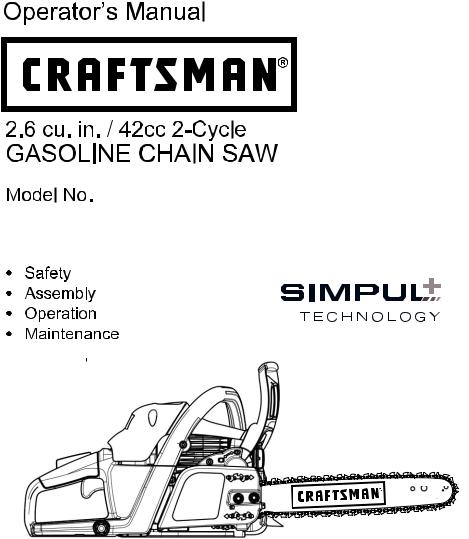
358.740160 — 16 IN. BAR
358.740180 — 18 IN. BAR






 22
22
IMPORTANT:
Read and follow all Safety Rules and Instructions before operating this equipment.
For answers to your questions about this product, call:
1-888-331-4569
Craftsman Customer Help Line
Sears Brands Management Corporation, Hoffman Estates, IL 60179 U.S.A.
Visit our Craftsman website: www.craftsman.com
115892449 REV. C 2017-06-08 |
SASA242PR |

TABLE OF CONTENTS
Warranty......................................................... |
2 |
Maintenance ................................................. |
15 |
Identification of Symbols ................................. |
3 |
Troubleshooting Table................................... |
19 |
Safety ............................................................. |
4 |
Technical Data .............................................. |
20 |
Know Your Product......................................... |
7 |
Emissions Statement..................................... |
20 |
Assembly........................................................ |
8 |
Spanish......................................................... |
22 |
Starting & Stopping......................................... |
9 |
Parts & Ordering ............................. |
Back Cover |
Working Techniques ..................................... |
11 |
|
|
WARRANTY
CRAFTSMAN LIMITED WARRANTY
FOR TWO YEARS from the date of sale this product is warranted against defects in material or workmanship.
WITH PROOF OF SALE a defective product will receive free repair. If the product cannot be repaired it will be replaced free of charge.
For warranty coverage details to obtain free repair, visit the web page: www.craftsman.com/warranty
This warranty covers ONLY defects in material and workmanship. Warranty coverage does NOT include:
Expendable items that can wear out from normal use within the warranty period, such as the chain bar, chain, filters or spark plug.
Product damage resulting from user attempts at product modification or repair or caused by product accessories.
Repairs necessary because of accident or failure to operate or maintain the product according to all supplied instructions.
Preventive maintenance, or repairs necessary due to improper fuel mixture, contaminated or stale fuel.
This warranty is void if this product is ever used while providing commercial services or if rented to another person.
This warranty gives you specific legal rights, and you may also have other rights which vary from state to state.
Sears Brands Management Corporation, Hoffman Estates, IL 60179
2
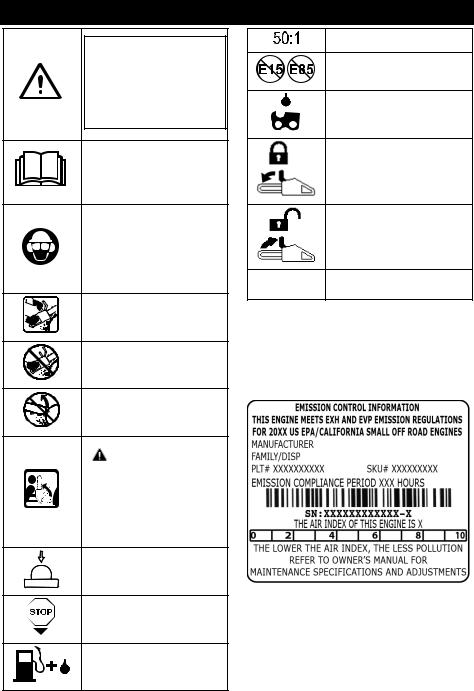
IDENTIFICATION OF SYMBOLS
 WARNING: Chainsaws can be dangerous! Careless or improper use can result in serious or fatal injury to the operator or others.
WARNING: Chainsaws can be dangerous! Careless or improper use can result in serious or fatal injury to the operator or others.
Please read the operator’s manual carefully and make sure you understand the instructions before using the machine.
Always wear:
Approved protective helmet
Approved hearing
protection
Protective goggles or a visor
Both of the operator′s hands must be used to operate the chainsaw.
Never operate a chainsaw holding it with one hand only.
Contact of the guide bar tip with any object must be avoided.
|
WARNING: Tip |
|
XX |
contact may cause the |
|
guide bar to move |
||
|
||
|
suddenly upward and |
|
|
backward (so-called |
|
|
kickback), which may |
|
|
cause serious injury. |
|
|
|
Primer (air purge) bulb.
The engine is stopped by switching the ignition off using the stop switch.
Fuel fill.
50:1 gasoline to oil ratio.
Do not use E15 or E85 blended fuels.
Bar and chain oil fill.
Lock chain brake.
Unlock chain brake.


 Chain brake unlocked/locked.
Chain brake unlocked/locked.
Other symbols/decals on the machine refer to special certification requirements for certain markets.
The Emissions Compliance Period referred to on the Emission Compliance label indicates the number of operating hours for which the engine has been shown to meet Federal emissions requirements.
Maintenance, replacement, or repair of the emission control devices and system may be performed by any nonroad engine repair establishment or individual.
3
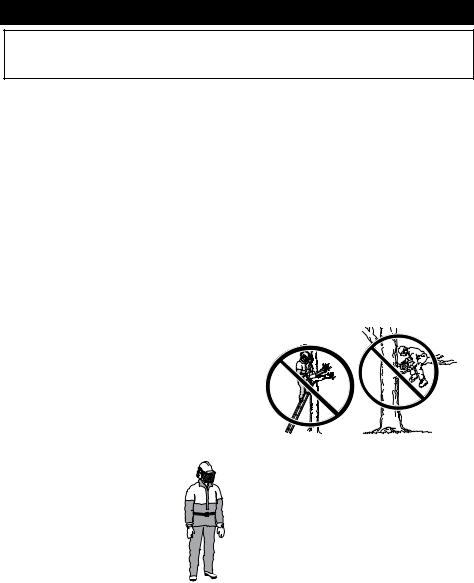
SAFETY
 WARNING: Always disconnect spark plug wire and place wire where it cannot contact spark plug to prevent accidental starting when setting up, transporting, adjusting or making repairs except carburetor adjustments.
WARNING: Always disconnect spark plug wire and place wire where it cannot contact spark plug to prevent accidental starting when setting up, transporting, adjusting or making repairs except carburetor adjustments.
STANDARDS
This saw has been designed in accordance with:
ANSI B175.1-2012 American National Standards for Gasoline-Powered Chain Saws - Safety Requirements
CSA Z62.1-11 Chain Saws – Occupational Health and Safety
CSA Z62.3-11 Chain Saw Kickback Occupational Health and Safety
INTRODUCTION
A chainsaw is a high speed wood cutting tool. Special safety precautions must be observed to reduce the risk of accidents.
Failure to follow all safety rules and precautions can result in serious injury.
If situations occur which are not covered in this manual, use care and good judgment. If you need assistance, contact your authorized service dealer or call consumer support.
PLANNING AHEAD
Read this manual carefully until you completely understand and can follow all safety rules, precautions, and operating instructions before attempting to use the unit.
Restrict the use of your saw to adult users who understand and can follow safety rules, precautions, and operating instructions found in this manual.
Wear protective gear. Always use steel toed safety footwear with non slip soles; snug fitting
clothing; safety chaps; heavy
duty, non slip gloves; eye protection such as non fogging, vented goggles or face screen; an
approved safety hard hat; and sound barriers (ear plugs or mufflers) to protect your hearing. Regular users should have
hearing checked regularly as chainsaw noise can damage hearing. Secure hair above shoulder length.
Keep all parts of your body away from the chain when the engine is running.
Keep children, bystanders, and animals a minimum of 30 feet (10 meters) away from the work area. Do not allow other people or animals to be near the chainsaw when starting or operating the chainsaw.
Do not handle or operate a chainsaw when you are fatigued, ill, or upset, or if you have taken alcohol, drugs, or medication. You
must be in good physical condition and mentally alert. Chainsaw work is strenuous. If you have any condition that might be aggravated by strenuous work, check with your doctor before operating a chainsaw.
Carefully plan your sawing operation in advance. Do not start cutting until you have a clear work area, secure footing, and, if you are felling trees, a planned retreat path.
OPERATING YOUR SAW
Do not operate a chainsaw with one hand. Serious injury to the operator, helpers, bystanders or any combination of these persons may result from one handed operation. A chainsaw is intended for two handed use.
Operate the chainsaw only in a well ventilated outdoor area.
Do not operate saw from a ladder or in a tree.
Make sure the chain will not make contact with any object while starting the engine. Never try to start the saw when the guide bar is in a cut.
Do not put pressure on the saw at the end of the cut. Applying pressure can cause you to lose control when the cut is completed.
Stop the engine before setting the saw down.
Do not operate a chainsaw that is damaged, improperly adjusted, or not completely and securely assembled. Always replace bar, chain, hand guard, or chain brake immediately if it becomes damaged, broken or is otherwise removed.
Exposure to vibrations through prolonged use of gasoline powered hand tools could cause blood vessel or nerve damage in the fingers, hands, and joints of people prone to circulation disorders or abnormal swellings. Prolonged use in cold weather has been linked to blood vessel damage in otherwise healthy people. If symptoms occur such as numbness, pain, loss of strength, change in skin color or texture, or loss of feeling in the fingers, hands, or joints, discontinue the use of this tool and seek medical attention. An
4
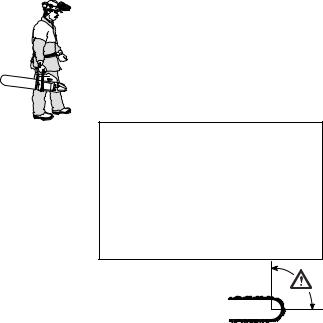
anti-vibration system does not guarantee the avoidance of these problems. Users who operate power tools on a continual and regular basis must monitor closely
their physical condition and the condition of this tool.
With the engine stopped, handcarry the chainsaw with the
muffler away from your body, and the guide bar and
chain to the rear, preferably covered with a scabbard.
MAINTAINING YOUR SAW
Have all chainsaw service performed by a qualified service dealer with the exception of the items listed in the maintenance section of this manual. For example, if improper tools are used to remove or hold the flywheel when servicing the clutch, structural damage to the flywheel can occur and cause the flywheel to burst.
Make certain the saw chain stops moving when the throttle trigger is released. For correction, refer to Carburetor Adjustment.
Never modify your saw in any way.
Keep the handles dry, clean, and free of oil or fuel mixture.
Keep fuel and oil caps, screws, and fasteners securely tightened.
Use only genuine accessories and replacement parts as recommended.
Your saw is equipped with a temperature limiting muffler and spark arresting screen which meets the requirements of California Codes 4442 and 4443. All U.S. forest land and the states of California, Idaho, Maine, Minnesota, New Jersey, Oregon, and Washington require by law that many internal combustion engines to be equipped with a spark arresting screen. If you operate a chainsaw in a state or locale where such regulations exist, you are legally responsible for maintaining the operating condition of these parts. Failure to do so is a violation of the law. Refer to the SERVICE section for maintenance of the spark arresting screen.
HANDLING FUEL
Do not smoke while handling fuel or while operating the saw.
Eliminate all sources of sparks or flame in the areas where fuel is mixed or poured. There should be no smoking, open flames, or work that could cause sparks. Allow engine to cool before refueling.
Always have fire extinguishing tools available if you should need them.
Mix and pour fuel in an outdoor area on bare ground; store fuel in a cool, dry, well ventilated place; and use an approved,
marked container for all fuel purposes. Wipe up all fuel spills before starting saw.
Move at least 10 feet (3 meters) from fueling site before starting engine.
Turn the engine off and let saw cool in a non combustible area, not on dry leaves, straw, paper, etc. Slowly remove fuel cap and refuel unit.
Store the unit and fuel in an area where fuel vapors cannot reach sparks or open flames from water heaters, electric motors or switches, furnaces, etc.
UNDERSTANDING KICKBACK
 WARNING: Avoid kickback which can result in serious injury. Kickback is the backward, upward or sudden forward motion of the guide bar occurring when the saw chain near the upper tip of the guide bar contacts any object such as a log or branch, or when the wood closes in and pinches the saw chain in the cut. Contacting a foreign object in the wood can also result in loss of chainsaw control.
WARNING: Avoid kickback which can result in serious injury. Kickback is the backward, upward or sudden forward motion of the guide bar occurring when the saw chain near the upper tip of the guide bar contacts any object such as a log or branch, or when the wood closes in and pinches the saw chain in the cut. Contacting a foreign object in the wood can also result in loss of chainsaw control.
Rotational Kickback
Rotational kickback can
occur when the moving
chain contacts an object at the upper tip of the
guide bar. This contact can cause the chain to dig into the object, which stops the chain for an instant. The result is a lightning fast, reverse reaction which kicks the guide bar up and back toward the operator.
Pinch Kickback
Pinch kickback can occur when the wood closes in and pinches the moving saw chain in the cut along the top of the guide bar and the saw chain is suddenly stopped. This sudden stopping of the chain results in a reversal of the chain force used to cut wood and causes the saw to move in the opposite direction of the chain rotation. The saw is driven straight back toward the operator.
Pull-In
Pull in can occur when the moving chain contacts a foreign object in the wood in the cut along the bottom of the guide bar and the saw chain is suddenly stopped. This sudden stopping pulls the saw forward and away from the operator and could easily cause the operator to lose control of the saw.
REDUCING THE CHANCE OF KICKBACK
Recognize that kickback can happen. With a basic understanding of kickback, you can reduce the element of surprise which contributes to accidents.
Never let the moving chain contact any object at the tip of the guide bar.
5

Keep the working area free from obstructions such as other trees, branches, rocks, fences, stumps, etc. Eliminate or avoid any obstruction that your saw chain could hit while you are cutting. When cutting a branch, do not let the guide bar contact branch or other objects around it.
Keep your saw chain sharp and properly tensioned. A loose or dull chain can increase the chance of kickback occurring. Follow manufacturer's chain sharpening and maintenance instructions. Check tension at regular intervals with the engine stopped, never with the engine running. Make sure the bar nuts are securely tightened after tensioning the chain.
Begin and continue cutting at full speed. If the chain is moving at a slower speed, there is greater chance of kickback occurring.
Use wedges made of plastic or wood. Never use metal to hold the cut open.
Cut one log at a time.
Use extreme caution when re entering a previous cut.
Do not attempt cuts starting with the tip of the bar (plunge cuts).
Watch for shifting logs or other forces that could close a cut and pinch or fall into chain.
Do not twist the saw as the bar is withdrawn from an undercut when bucking.
Use the reduced-kickback guide bar and lowkickback chain specified for your saw.
MAINTAINING CONTROL
Keep a good, firm grip on
the saw with both hands
when the engine is running and don't let go. A firm grip will help you
reduce kickback and maintain control of the saw.
Keep the fingers of your left hand encircling and your left thumb under the front handlebar. Keep your right hand completely around the rear handle whether you are right handed or left handed. Keep your left arm straight with the elbow locked.
Position your left hand on the front handlebar so it is in a straight line with your right hand on the rear handle when making bucking cuts. Never reverse right and left hand positions for any type of cutting.
Stand with your weight evenly balanced on both feet.
Stand slightly to the left side of
the saw to keep your body from being in a direct
line with the cutting chain.
Do not overreach. You could be drawn or thrown off balance and lose control of the saw.
Do not cut above shoulder height. It is difficult to maintain control of saw above shoulder height.
KICKBACK SAFETY FEATURES
 WARNING: The following features are included on your saw to help reduce the hazard of kickback; however, such features will not totally eliminate this danger. As a chainsaw user, do not rely only on safety devices. You must follow all safety precautions, instructions, and maintenance in this manual to help avoid kickback and other forces which can result in serious injury.
WARNING: The following features are included on your saw to help reduce the hazard of kickback; however, such features will not totally eliminate this danger. As a chainsaw user, do not rely only on safety devices. You must follow all safety precautions, instructions, and maintenance in this manual to help avoid kickback and other forces which can result in serious injury.
Reduced Kickback Guide Bar
The reduced-kickback guide bar is designed with a small radius tip which reduces the size of the kickback danger zone on the bar tip. A reduced-kickback guide bar has been demonstrated to significantly reduce the number and seriousness of kickbacks when tested in accordance with safety requirements for gasoline powered chainsaws as set by ANSI B175.1.
Low-Kickback Chain
A low-kickback chain is designed with a contoured depth gauge and guard link which deflect kickback force and allow wood to gradually ride into the cutter. Low-kickback chain has met kickback performance requirements when tested on a representative sample of chainsaws below 3.8 cubic inch displacement specified in ANSI B175.1.
Front Hand Guard
The front hand guard is designed to reduce the chance of your left hand contacting the chain if your hand slips off the front handlebar.
The distance and “in line” position of the hands provided by the front and rear handles work together to give balance and resistance in controlling the pivot of the saw back toward the operator if kickback occurs.
Chain Brake
The chain brake is designed to stop the chain in the event of kickback.
NOTE: We do not represent and you should not assume that the chain brake will protect you in the event of a kickback. Do not rely upon any of the devices built into your saw. You should use the saw properly and carefully to avoid kickback.
Chain brake repairs should only be made by a Sears or other qualified service dealer.
NOTE: If this saw is to be used for commercial logging, a chain brake is required and shall not be removed or otherwise disabled to comply with Federal OSHA Regulations for Commercial Logging.
6

KNOW YOUR PRODUCT
NOTE: The appearance of your product may vary from the item shown.
(*) = Configuration for models equipped with chain tensioning screw located on front. Does not apply to all models.
(**) = Configuration for models equipped with chain tensioning screw located on side. Does not apply to all models.
1. |
Combination tool |
11. Fuel mix fill cap |
22. |
Chain brake |
|
2. |
Chain |
12. Starter housing |
23. |
Cutters |
|
3. |
Front hand guard/chain |
13. Bar and chain oil fill cap |
24. |
Depth gauge |
|
|
brake lever |
14. |
Bumper spike |
25. |
Drive links |
|
|
||||
4. |
Muffler |
15. |
Cylinder cover |
26. |
Chain direction of travel |
|
|
||||
5. |
Front handle |
16. |
Throttle lock-out |
27. |
Guide bar retaining nuts |
|
|
||||
6. |
Starter rope |
17. |
Rear handle |
28. |
Chain tensioning screw |
|
|
||||
7. |
Idle speed screw |
18. |
Throttle trigger |
29. |
Manual |
|
|
||||
8. |
ON/STOP switch |
19. |
Clutch cover |
30. |
Scabbard |
|
|
||||
9. |
Choke/fast idle lever |
20. |
Chain catcher |
31. |
Carrying case |
|
|
||||
10. |
Primer (air purge) bulb |
21. |
Guide bar |
|
|
|
|
|
|
||
7

The ON/STOP SWITCH (8) is used to stop the engine.
The THROTTLE TRIGGER (18) controls engine speed.
The THROTTLE LOCK--OUT (16) must be pressed before you can squeeze the throttle trigger. This feature prevents you from accidentally squeezing the trigger.
The choke and fast idle are set by pulling the CHOKE/FAST IDLE LEVER (9) out to the full extent for cold starting or after refueling. The choke provides additional fuel to the engine during cold starting.
The PRIMER (AIR PURGE) BULB (10) circulates fuel to the carburetor to provide quicker starting.
The CHAIN BRAKE (3) is a device designed to stop the chain if kickback occurs. The chain brake activates automatically in the event of kickback. The chain brake activates manually if the front hand guard is pushed forward. The chain brake is disengaged by pulling the front hand guard back toward the front handle as far as possible.
ASSEMBLY
If received assembled, repeat all steps to ensure your saw is properly assembled and all fasteners are secure.
1.Check that the chain brake is in the unlocked position by pulling the front hand guard towards the front handle.
2.Loosen and remove the bar nuts and the clutch cover from the saw.
3.Remove the plastic shipping spacer (A) if present.
sprocket. Cutters must face in the direction of rotation.
7.Check that the drive links of the chain fit correctly on the drive sprocket and that the chain is in the groove on the bar.
8.Fit the clutch cover and insert the adjusting pin in the cut-out in the bar.
9.Tighten the bar nut finger-tight.
10.Tension the chain by turning the chain tensioning screw clockwise using the combination tool. The chain is correctly tensioned when it does not sag from the underside of the bar, but can still be turned easily by hand.
Chain tensioningside adjust models
4.An adjusting pin and screw is used to adjust the tension of the chain. It is very important when assembling the bar that the adjusting pin located on the adjusting screw aligns into a hole in the bar. Turning the screw will move the adjusting pin up and down the screw. Locate this adjusting pin before you begin mounting the bar onto the saw. See following illustration.
5.Turn the adjusting screw by hand counterclockwise until the adjusting pin is positioned between the indicator marks (B) on the clutch cover. This should allow the adjusting pin to be near the correct position.
6.Slide guide bar with chain on bar bolts until guide bar stops against clutch drum
Chain tensioningfront adjust models
11.Hold up the bar tip and tighten the bar nuts with the combination tool.
When fitting a new chain, the chain tension has to be checked frequently until the chain is runin. Check the chain tension regularly. A correctly tensioned chain ensures good cutting performance and long life.
8
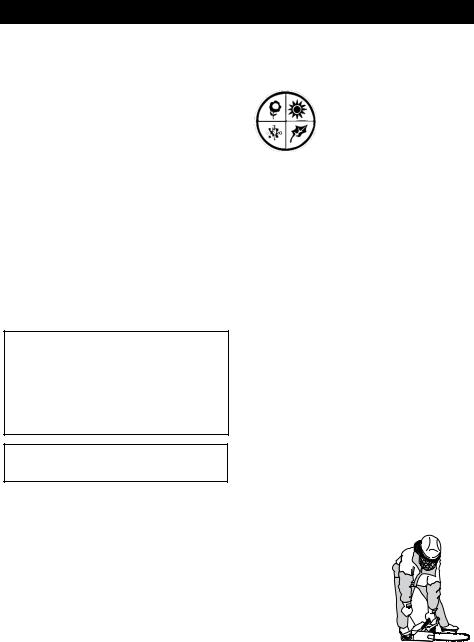
STARTING AND STOPPING
PRE-OPERATION INSPECTION
Perform the following steps before every use of the machine:
Check fuel mixture level
Check bar lubrication
Check chain sharpness
NOTE: Chain sharpening is a complicated task that requires special tools. We recommend that you refer chain sharpening to a professional chain sharpener.
Check chain tension
Inspect and clean the guide bar
Check for damaged parts
Check for loose caps
Check for loose fasteners
Check for loose parts
Check for fuel and oil leaks
NOTE: It is normal for a small amount of oil to appear under the saw after the engine stops. Do not confuse this with a leaking oil tank.
FUELING THE ENGINE
 WARNING: Be sure to read the fuel handling information in the safety rules section of this manual before you begin. If you do not understand the fuel handling information do not attempt to fuel your unit. Seek help from someone that does understand the information or call the consumer assistance help line.
WARNING: Be sure to read the fuel handling information in the safety rules section of this manual before you begin. If you do not understand the fuel handling information do not attempt to fuel your unit. Seek help from someone that does understand the information or call the consumer assistance help line.
 WARNING: Remove the fuel cap slowly when fueling.
WARNING: Remove the fuel cap slowly when fueling.
This equipment is designed to operate on unleaded gasoline with a minimum 87 octane (R+M/2 method), with ethanol blended up to 10% maximum by volume (E-10).
Before operation, gasoline must be mixed with a good quality full synthetic 2-cycle air-cooled engine oil designed to be mixed at a ratio of 50:1.
A 50:1 ratio is obtained by mixing 2.6 fluid ounces of full synthetic oil with 1 gallon of unleaded gasoline. DO NOT USE automotive oil or marine oil. These oils will cause engine damage.
When mixing fuel, follow the instructions printed on the container. Once the oil is added to the gasoline, shake the container momentarily to assure that the fuel is thoroughly mixed.
Fill the fuel tank completely with properly mixed fuel.
Always read and follow the safety rules relating to fuel before fueling your unit.
Purchase fuel in quantities that can be used within 30 days to assure fuel freshness.
HELPFUL TIP
During storage of your fuel mixture, the oil will separate from the gasoline.
Shake the fuel can weekly to insure proper blending of the gasoline and oil.
CAUTION: Never use unmixed gasoline in your unit. This will cause permanent engine damage and void the limited warranty.
CAUTION: Do not use alternate fuels such as ethanol blends above 10% by volume (E-15, E- 85) or any methanol blended fuel. Use of these fuels can cause major engine performance problems and void the limited warranty.
BAR AND CHAIN LUBRICATION
The bar and chain require continuous lubrication. Lubrication is provided by the automatic oiler system when the oil tank is kept filled. Lack of oil will quickly ruin the bar and chain. Too little oil will cause overheating shown by smoke coming from the chain and/or discoloration of the bar. In freezing weather oil will thicken, making it necessary to thin bar and chain oil with a small amount (5 to 10%) of #1 diesel fuel or kerosene. Bar and chain oil must be free flowing for the oil system to pump enough oil for adequate lubrication.
If bar and chain oil is not available, use a good grade SAE 30 oil.
Fill the oil tank completely with oil.
CAUTION: Never use waste oil for bar and chain lubrication.
CAUTION: Always stop the engine before removing the oil cap.
STARTING POSITION
1. Lay the chainsaw on a
flat surface. The cutting attachment must not be in contact with the
ground.
2. Lock the chain brake by
pushing forward on the handguard.
3. Place your left hand on the handlebar and your
right hand on the starter rope. Push your right foot into the rear handle to stabilize the chainsaw.
4. Follow the starting instructions.
9

STOPPING THE CHAIN
To stop the chain, release the throttle trigger. The chain will stop moving, but the engine will continue to run.
Wait until the chain has completely stopped before setting down the chainsaw or carrying it to another location.
 WARNING: NEVER touch the chain if it is still moving! Even a very slowly moving chain can inflict severe cuts to hands and fingers.
WARNING: NEVER touch the chain if it is still moving! Even a very slowly moving chain can inflict severe cuts to hands and fingers.
STOPPING THE ENGINE
Press the red stop switch to stop the engine.
STARTING THE ENGINE
Follow these instructions to start your chainsaw. Your chainsaw has a starting reminder decal similar to the one shown below:
Starting A Cold Engine
Before starting, push the front hand guard toward guide bar to lock chain brake.
Press the primer (air purge) bulb 10 times until fuel begins to fill the bulb. The primer (air purge) bulb does not need to be completely filled.
Pull the blue choke lever to the FULL
CHOKE position. The red ON/STOP switch will be switched automatically to the ON position.
Using your right hand, pull the starter rope until the machine attempts to start, or a maximum of 5 times.
NOTE: This unit has the SIMPUL+ starting system. You do not have to pull the starter rope handle sharply or briskly.
NOTE: If the engine sounds as if it is trying to start before the fifth pull, stop pulling and immediately proceed to the next step.
NOTE: Do not attempt to cut material with the choke/fast idle lever in the FULL CHOKE position.
Push the blue choke lever to the HALF
CHOKE position.
NOTE: In temperatures above 90°F (32°C), push the blue choke lever completely in.
Pull the starter rope sharply with your right hand until the engine starts.
Allow the engine to run for 30 seconds.
Push the blue choke lever completely in.
Before accelerating to full throttle, pull the front hand guard towards the front handle. The chain brake is now unlocked. Your chainsaw is now ready for use.
 WARNING: The chain must not move when the engine runs at idle speed. If the chain moves at idle speed refer to CARBURETOR ADJUSTMENT within this manual.
WARNING: The chain must not move when the engine runs at idle speed. If the chain moves at idle speed refer to CARBURETOR ADJUSTMENT within this manual.
 WARNING: Do not attempt to throw or drop-start the chainsaw. Doing so will put the operator at risk of serious injury due to loss of control of the chainsaw.
WARNING: Do not attempt to throw or drop-start the chainsaw. Doing so will put the operator at risk of serious injury due to loss of control of the chainsaw.
 WARNING: The muffler is very hot during and after use. Do not touch the muffler or allow combustible material such as dry grass or fuel to do so.
WARNING: The muffler is very hot during and after use. Do not touch the muffler or allow combustible material such as dry grass or fuel to do so.
HELPFUL TIP
If your engine still does not start after following the instructions, contact consumer assistance.
Starting A Warm Engine
Before starting, push the front hand guard toward guide bar to lock chain brake.
Press the primer (air purge) bulb 10 times until fuel begins to fill the bulb. The primer (air purge) bulb does not need to be completely filled.
Pull the blue choke lever to the FULL
CHOKE position. The red ON/STOP switch will be switched automatically to the ON position.
Push the blue choke lever completely in.
Pull the starter rope with your right hand until the engine starts.
Before accelerating to full throttle, pull the front hand guard towards the front handle. The chain brake is now unlocked. Your chainsaw is now ready for use.
10
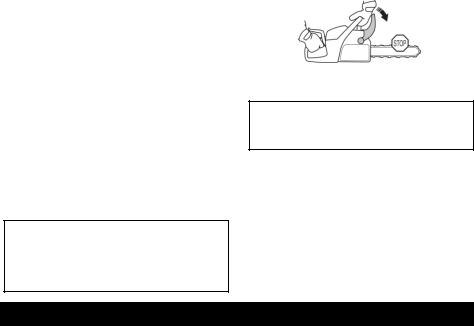
NOTE: If the product does not restart, the problem could be overheated fuel.
To fix this problem, try the following procedure:
1.Set the product in a cool area away from direct sunlight.
2.Allow the product to cool for at least 20 minutes.
3.Press primer (air purge) bulb repeatedly for 10-15 seconds.
4.Follow the cold starting procedure.
Repeat this procedure if the problem still exists.
NOTE: Always use fresh seasonal fuel and shorten operation time during unseasonably warm weather.
Starting A Flooded Engine
The engine may be flooded with too much fuel if it has not started after 10 pulls.
Flooded engines can be restarted by pushing the blue choke lever in completely to the OFF CHOKE position and then following the warm engine starting procedure listed above. Ensure the red ON/STOP switch is in the ON position.
Starting could require pulling the starter rope handle many times depending on how badly the unit is flooded. If the engine fails to start, refer to the TROUBLESHOOTING TABLE or call the consumer assistance help line.
CHAIN TENSION
It is normal for a new chain to stretch during the first 15 minutes of operation. You should check your chain tension each time before you start the chainsaw. See the chain tensioning instructions in the ASSEMBLY section.
 WARNING: If the saw is operated with a loose chain, the chain could jump off the guide bar and result in serious injury to the operator and/or damage the chain, making it unusable.
WARNING: If the saw is operated with a loose chain, the chain could jump off the guide bar and result in serious injury to the operator and/or damage the chain, making it unusable.
CHECKING THE CHAIN BRAKE
The chain brake must be checked before each use. The engine must be running when performing this procedure.
This is the only instance when the saw should be placed on the ground with the engine running.
1.Place the saw on firm ground.
2.Grip the rear handle with your right hand and the front handle with your left hand.
3.Apply full throttle by fully depressing the throttle trigger.
4.Activate the chain by turning your left wrist to contact the front hand guard without releasing your grip around the front handle. The chain should stop immediately.
CHECKING THE INERTIA ACTIVATING FUNCTION CONTROL
 WARNING: When performing the following procedure, the engine must be turned off.
WARNING: When performing the following procedure, the engine must be turned off.
1.Grip the rear handle with your right hand and the front handle with your left hand.
2.Hold the chainsaw approximately 16-18 inches (40-45 centimeters) above a stump or other wooden surface.
3.Release your grip on the front handle and use the weight of the saw to let the tip of the guide bar fall forward and contact the stump. When the tip of the bar hits the stump, the brake should activate as observed by the front hand guard snapping forward toward the guide bar.
WORKING TECHNIQUES
PRACTICING YOUR CUTS
Practice cutting a few small logs using the following techniques to get the “feel” of using your saw before you begin a major sawing operation.
Squeeze the throttle trigger and allow the engine to reach full speed before cutting.
Begin cutting with the saw frame against the log.
Keep the engine at full speed the entire time you are cutting.
Allow the chain to cut for you. Exert only light downward pressure. If you force the cut, damage to the guide bar, chain, or engine can result.
Release the throttle trigger as soon as the cut is completed, allowing the engine to idle. If you run the saw at full throttle without a cutting load, unnecessary wear can occur to the chain, guide bar, and engine. It is recommended that the engine not be operated for longer than 30 seconds at full throttle.
To avoid losing control when cut is complete, do not put pressure on saw at end of cut.
Stop the engine before setting the saw down after cutting.
11

FELLING A TREE
Planning
 WARNING: Check for broken or dead branches which can fall while cutting causing serious injury. Do not cut near buildings or electrical wires if you do not know the direction of tree fall, nor cut at night since you will not be able to see well, nor during bad weather such as rain, snow, or strong winds, etc. If the tree makes contact with any utility line, the utility company should be notified immediately.
WARNING: Check for broken or dead branches which can fall while cutting causing serious injury. Do not cut near buildings or electrical wires if you do not know the direction of tree fall, nor cut at night since you will not be able to see well, nor during bad weather such as rain, snow, or strong winds, etc. If the tree makes contact with any utility line, the utility company should be notified immediately.
Carefully plan your sawing operation in advance.
Clear the work area. You need a clear area all around the tree so you can have secure footing.
The chainsaw operator should keep on the uphill side of the terrain as the tree is likely to roll or slide downhill after it is felled.
Study the natural conditions that can cause the tree to fall in a particular direction.
Natural conditions that can cause a tree to fall in a particular direction include:
The wind direction and speed.
The lean of the tree. The lean of a tree might not be apparent due to uneven or sloping terrain. Use a plumb or level to determine the direction of tree lean.
Weight and branches on one side.
Surrounding trees and obstacles.
Look for decay and rot. If the trunk is rotted, it can snap and fall toward the operator. Check for broken or dead branches which can fall on you while cutting.
Make sure there is enough room for the tree to fall. Maintain a distance of 2-1/2 tree lengths from the nearest person or other objects. Engine noise can drown out a warning call.
Remove dirt, stones, loose bark, nails, staples, and wire from the tree where cuts are to be made.
Plan a clear retreat path to the rear and diagonal to the line of fall. Note the danger zone (1), retreat path (2), and felling direction
(3) in the following diagram.
D |
|
|
|
|
|
|
|
|
|
|
|
a |
|
|
|
|
|
|
|
|
|
|
|
n |
|
o |
|
|
|
|
direction |
|
|
||
g |
|
|
|
|
|
|
|||||
|
erz |
n |
|
|
|
|
|
|
|
||
|
|
|
|
|
|
|
|
|
|
||
|
|
|
|
e |
|
Felling |
|
|
|
||
Retreat path |
path |
|
1 |
|
|||||||
|
|
|
|
3 |
|||||||
|
|
|
|
|
n |
|
|
2 |
|||
|
|
|
|
|
|
|
|
||||
|
|
|
|
|
|
D |
|
|
|
|
|
|
|
zone |
|
a |
g |
|
|
|
|||
|
|
|
|
|
|
|
|||||
Danger |
|
|
|
Retreat |
|
|
er |
|
|
|
|
|
|
|
|
|
|
e |
1 |
|
|||
|
|
|
|
|
|
|
|
z |
|
1 |
|
|
|
|
|
|
|
|
|
|
on |
|
|
|
|
|
|
|
|
|
|
|
|
|
2 |
Using The Notch Method
The notch method is used to fell large trees. A notch is cut on the side of the tree in the desired direction of fall. After a felling cut is made on the opposite side of tree, the tree will tend to fall into the notch.
NOTE: If the tree has large buttress roots, remove them before making the notch. If using saw to remove buttress roots, keep saw chain from contacting ground to prevent dulling of the chain.
Make the notch cut by cutting the top of the notch first. Cut through 1/3 of the diameter of the tree. Next complete the notch by cutting the bottom of the notch. Once the notch is cut remove the notch of wood from the tree.
After removing the wood from the notch, make the felling cut on the opposite side of the notch. This is done by making a cut about two inches (5 cm) higher than the center of the notch. This will leave enough uncut wood between the felling cut and the notch to form a hinge. This hinge will help prevent the tree from falling in the wrong direction.
NOTE: Before felling cut is complete, use wedges to open the cut if necessary to control the direction of fall. To avoid kickback and chain damage, use wood or
12
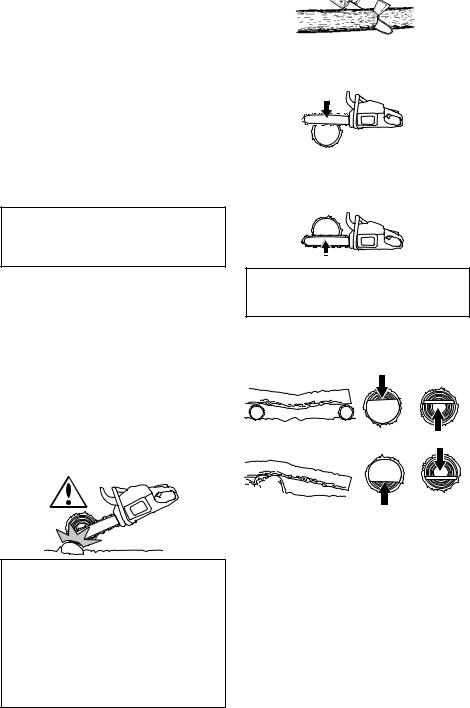
plastic wedges, but never steel or iron wedges.
Be alert to signs that the tree is ready to fall: cracking sounds, widening of the felling cut, or movement in the upper branches.
As tree starts to fall, stop saw, put it down, and get away quickly on your planned retreat path.
DO NOT cut down a partially fallen tree with your saw. Be extremely cautious with partially fallen trees that may be poorly supported.
When a tree doesn’t fall completely, set the saw aside and pull down the tree with a cable winch, block and tackle, or tractor.
CUTTING A FALLEN TREE (BUCKING)
Bucking is the term used for cutting a fallen tree to the desired log size.
 WARNING: Do not stand on the log being cut. Any portion can roll causing loss of footing and control. Do not stand downhill of the log being cut.
WARNING: Do not stand on the log being cut. Any portion can roll causing loss of footing and control. Do not stand downhill of the log being cut.
Important Points
Cut only one log at a time.
Cut shattered wood very carefully; sharp pieces of wood could be flung toward operator.
Use a sawhorse to cut small logs. Never allow another person to hold the log while cutting and never hold the log with your leg or foot.
Do not cut in an area where logs, limbs, and roots are tangled such as in a blown down area. Drag the logs into a clear area before cutting by pulling out exposed and cleared logs first.
Make sure the chain will not strike the ground or any other object during or after cutting.
 WARNING: If saw becomes pinched or hung in a log, don’t try to force it out.
WARNING: If saw becomes pinched or hung in a log, don’t try to force it out.
You can lose control of the saw resulting in injury and/or damage to the saw. Stop the saw, drive a wedge of plastic or wood into the cut until the saw can be removed easily. Restart the saw and carefully reenter the cut. To avoid kickback and chain damage, do not use a metal wedge. Do not attempt to restart your saw when it is pinched or hung in a log.
Types Of Bucking Cuts
Overcutting begins on the top side of the log with the bottom of the saw against the log. When overcutting use light downward pressure.
Undercutting involves cutting on the underside of the log with top of saw against the log. When undercutting use light upward pressure. Hold saw firmly and maintain control. The saw will tend to push back toward you.
 WARNING: Never turn saw upside down to undercut. The saw cannot be controlled in this position.
WARNING: Never turn saw upside down to undercut. The saw cannot be controlled in this position.
Always make your first cut on the compression side of the log. The compression side of the log is where the pressure of the log’s weight is concentrated.
Bucking Without A Support
1.Overcut through 1/3 of the diameter of the log.
2.Roll the log over and finish with a second overcut.
NOTE: Watch for logs with a compression side to prevent the saw from pinching.
Bucking Using A Log Or Support Stand
1.Make the first cut on the compression side of the log. Your first cut should extend 1/3 of the diameter of the log.
2.Finish with your second cut.
13
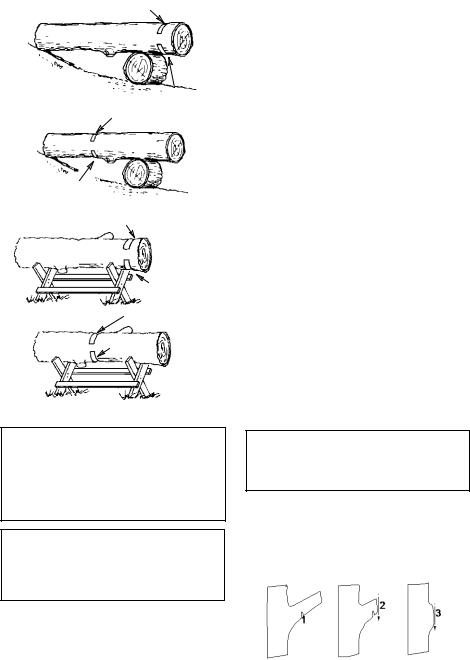
2
1
1
2
2
1
1
2
LIMBING AND PRUNING
 WARNING: Be alert for and guard against kickback. Do not allow the moving chain to contact any other branches or objects at the nose of the guide bar when limbing or pruning. Allowing such contact can result in serious injury.
WARNING: Be alert for and guard against kickback. Do not allow the moving chain to contact any other branches or objects at the nose of the guide bar when limbing or pruning. Allowing such contact can result in serious injury.
 WARNING: Never climb into a tree to limb or prune. Do not stand on ladders, platforms, a log, or in any position which can cause you to lose your balance or control of the saw.
WARNING: Never climb into a tree to limb or prune. Do not stand on ladders, platforms, a log, or in any position which can cause you to lose your balance or control of the saw.
Important Points
Work slowly, keeping both hands firmly gripped on the saw. Maintain secure footing and balance.
Watch out for springpoles. Springpoles are small size limbs which can catch the saw chain and whip toward you or pull you off balance. Use extreme caution when cutting small size limbs or slender material.
Be alert for springback. Watch out for branches that are bent or under pressure. Avoid being struck by the branch or the saw when the tension in the wood fibers is released.
Keep a clear work area. Frequently clear branches out of the way to avoid tripping over them.
Limbing
Always limb a tree after it is cut down. Only then can limbing be done safely and properly.
Leave the larger limbs underneath the felled tree to support the tree as you work.
Start at the base of the felled tree and work toward the top, cutting branches and limbs. Remove small limbs with one cut.
Keep the tree between you and the chain. Cut from the side of the tree opposite the branch you are cutting.
Remove larger, supporting branches with the cutting techniques described in BUCKING WITHOUT A SUPPORT.
Always use an overcut to cut small and freely hanging limbs. Undercutting could cause limbs to fall and pinch the saw.
Pruning
 WARNING: Limit pruning to limbs shoulder height or below. Do not cut if branches are higher than your shoulder. Get a professional to do the job.
WARNING: Limit pruning to limbs shoulder height or below. Do not cut if branches are higher than your shoulder. Get a professional to do the job.
1.Make the first cut one-third of the way through the bottom of the limb.
2.Make the second cut all the way through the limb.
3.Make the third overcut leaving a 1 to 2 inch (2.5 to 5 cm) collar from the trunk of the tree.
14
